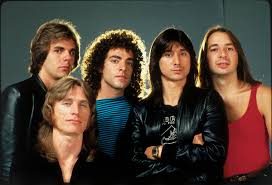Journey: Overview and Impact as Music Artists
Journey is an American rock band formed in San Francisco in 1973, known for their blend of arena rock, progressive rock, and melodic pop elements. Initially formed by former members of Santana, the band evolved into a mainstream success with the addition of vocalist Steve Perry in 1977. Their music is characterized by soaring vocals, memorable melodies, and anthemic choruses. Journey’s catalog includes iconic hits like “Don’t Stop Believin’,” “Faithfully,” and “Open Arms,” which have cemented their place as one of the most successful and enduring bands in rock history. With over 100 million records sold worldwide, Journey’s impact on music and popular culture continues to resonate.
Key Phases in Journey’s Career
- Formation and Early Progressive Era (1973-1977): Journey was founded by Neal Schon (guitar) and Gregg Rolie (keyboards, vocals), both former members of Santana, alongside Ross Valory (bass), George Tickner (rhythm guitar), and Prairie Prince (drums). Their early work leaned toward jazz-fusion and progressive rock, evident in albums like Journey (1975) and Look into the Future (1976). While these albums showcased the band’s technical prowess, they achieved limited commercial success.
- Rise to Fame with Steve Perry (1977-1980): The addition of Steve Perry as lead vocalist marked a turning point for Journey. With his powerful, emotive voice, Perry shifted the band’s sound toward a more radio-friendly, melodic rock style. The album Infinity (1978), featuring hits like “Wheel in the Sky,” became a breakthrough, achieving multi-platinum status. Subsequent albums, including Evolution (1979) and Departure (1980), further established Journey’s presence in the rock world.
- Mainstream Success and Arena Rock Dominance (1981-1986): Journey’s commercial peak came with Escape (1981), which included their signature hit “Don’t Stop Believin’,” now one of the most downloaded songs in digital history. The album also featured hits like “Open Arms” and “Who’s Crying Now,” solidifying their status as arena rock icons. Frontiers (1983) followed, with hits like “Faithfully” and “Separate Ways (Worlds Apart).” During this era, Journey became one of the most successful touring bands, known for their electrifying live performances.
- Hiatus and Shifts in Lineup (1987-1995): Following the success of Raised on Radio (1986), internal tensions and fatigue led to the band’s hiatus. Members pursued solo projects, with Steve Perry enjoying success as a solo artist. Journey briefly reunited in 1995 for the album Trial by Fire, which was well-received but did not lead to a sustained comeback due to Perry’s health issues.
- Rebirth with New Vocalists (1998-Present): After Perry’s departure, Journey continued with a series of vocalists, including Steve Augeri and, later, Arnel Pineda, who joined in 2007. Pineda, discovered on YouTube, revitalized the band with his strikingly similar vocal style to Perry. Albums like Revelation (2008) and Eclipse (2011) showcased their continued relevance, and their extensive touring brought their music to new generations of fans.
Journey Greatest Hits Playlist:
Musical Style and Themes
Journey’s music is defined by its blend of rock and pop, characterized by Neal Schon’s expressive guitar work, Perry’s soaring vocals, and strong melodic hooks. Their lyrics often explore themes of love, perseverance, and personal triumph, resonating with audiences through relatable storytelling. Songs like “Don’t Stop Believin’” have become anthems of hope and resilience, while ballads like “Open Arms” showcase their ability to convey deep emotional connection.
Legacy and Influence
- Icons of Arena Rock: Journey helped define the arena rock genre, creating anthems designed for massive stadiums and singalong moments. Their sound and approach to songwriting influenced bands like Foreigner, Bon Jovi, and Def Leppard, and their focus on melody and emotional resonance continues to inspire modern rock bands.
- Cultural Impact and Longevity: “Don’t Stop Believin’” has become a cultural phenomenon, widely used in films, TV shows, and events, including its iconic feature in the finale of The Sopranos. Journey’s music transcends generations, appealing to both original fans and younger audiences, ensuring their relevance in pop culture.
- Success as a Touring Act: Journey remains one of the most successful live acts in rock history, known for their dynamic performances and enduring appeal. Their tours consistently draw large crowds, demonstrating their lasting popularity.
- Resurgence Through Digital Media: Journey’s music has experienced a renaissance in the digital era, with “Don’t Stop Believin’” becoming one of the most downloaded tracks of the 21st century. Streaming platforms and social media have introduced their music to a global audience, reinforcing their status as one of the greatest rock bands of all time.
- Recognition and Accolades: Journey was inducted into the Rock and Roll Hall of Fame in 2017, recognizing their contributions to rock music and enduring legacy. Their influence on rock and popular music continues to be celebrated by fans and musicians alike.
Conclusion
Journey’s blend of anthemic rock and heartfelt ballads has made them one of the most beloved bands in rock history. With their timeless hits, unparalleled musicianship, and ability to connect with audiences across generations, Journey’s music remains a cornerstone of classic rock. Their legacy as pioneers of arena rock and cultural icons ensures that their influence will endure for years to come.
Journey YouTube Channel:
https://www.youtube.com/channel/UCCcn1f6IDJyXVNYoiYIGZFw
References:
- Daniels, N. (2011). Don’t Stop Believin’: The Untold Story of Journey. Omnibus Press.
- “Journey.” Rock and Roll Hall of Fame, inducted in 2017.
- “The Legacy of Journey: From Arena Rock to Cultural Icons.” Rolling Stone, 2020.
- Prato, G. (2021). “Journey Biography.” AllMusic.
- Perry, S. (2019). Traces: My Life with Journey and Beyond. HarperCollins.


Leave a Reply